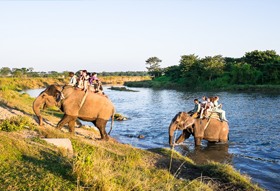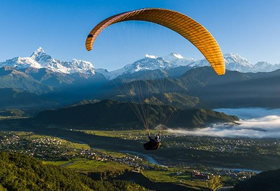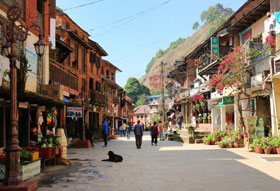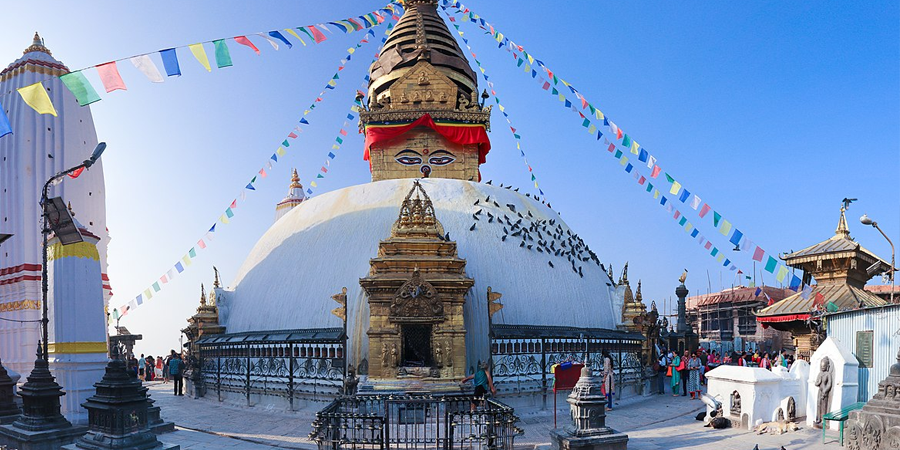


Arrive Kathmandu, upon arrival our assistance will be at the airport to receive the guest, transfer to hotel. Overnight stay at hotel.
Breakfast at hotel. After breakfast:
AM: Sightseeing tour of Pashupatinath and Bouddhanath

Pashupatinath is the most important temple dedicated to Lord Shiva. Every year this temple attracts hundreds of elderly followers of Hinduism. This precinct is an extensive collection of temples, ashrams, images and inscriptions raised over the centuries along the banks of the sacred Bagmati river, and is one of seven monument groups in UNESCO's designation of Kathmandu Valley. The earliest evidence of the temple’s existence dates back to 400 A.D. The current main temple of Pashupatinath complex was built in the end of the 17th century to replace the previous one, destroyed by termites.
This temple was classified as a World Heritage Site by UNESCO in 1979.

Bouddhanath epitomizes the Tibetan Buddhism. It was built in 5th Century AD and is regarded as one of the world's biggest stupas. It has been built on stepped octagonal base and inset with alcoves representing Buddha and his teachings. The stupa is surrounded by various temples or 'gompas'. This stupa is one of the most visited places in Kathmandu. The Bouddhanath Stupa is about two kilometers east of the Pashupatinath temple.
It is constructed with three tiers and designed in a huge circular belt. Below the circular belt, you can see the womb of this Mahachaitya. In the lower belt, many prayer circles are placed, which have added extra charm to the stupa. Small idols of the Tantric Buddhist deities are built around the womb of the stupa like Tara, Lokeshwar etc. There are a total 108 deities in the womb. Pinnacle and umbrellas are placed above the womb of the stupa. Exterior design of this stupa is somehow similar to Swayambhunath as it has the same eyes and symbols.
It was classified as World Heritage Site by UNESCO in 1979.

PM: Proceed to Nagarkot. Enroute sightseeing tour of Bhaktapur
Bhaktapur Durbar Square is a former royal palace complex located in Bhaktapur, Nepal. It housed the Malla kings of Nepal from 14th to 15th century and the kings of the Kingdom of Bhaktapur from 15th to late 18th century until the kingdom was conquered in 1769. Today, this square is recognized by UNESCO managed jointly by the Archeological Department of Nepal and Bhaktapur Municipality and is under heavy restoration due to the damages from the earthquake in 1934 and the recent earthquake of 2015.
The Durbar Square is a generic name for the Malla palace square and can be found in Kathmandu and Patan as well. The one in Bhaktapur was considered the biggest and the grandest among the three during its independency but now many of the buildings that once occupied the square has been lost to the frequent earthquakes. During its height, Bhaktapur Durbar Square contained 99 courtyards but today hardly 15 of these courtyards remain. The square has lost most of its buildings and courtyards to frequent earthquakes, particularly those in 1833 and 1934 and only a few of the damaged buildings were restored.

Nagarkot is one of the most scenic spots located at an altitude of 2211m, from where an excellent view of snowcapped peaks of the Himalayan Ranges can be seen (if the weather permits). It is also well known for the spectacular sunrise. It is also the nearest place to see Mount Everest from Kathmandu valley. If the weather conditions are clear, we can see the Annapurna range too. Nagarkot is 32 km NE of Kathmandu on the northern fringe of the Kathmandu Valley. The Himalayan peaks at sunrise are a magnificent sight to behold. It is surrounded by thickly forested hills of pine trees which give you an idyllic scene.
It is a rustic resort high on the northern fringe of the Kathmandu valley. It is an outstanding hilltop that offers great views of Himalayas, breathtaking mountain scenery and the most impressive views of sunrise and sunset.
Nagarkot commands one of the broadest views of the Himalayas in the Kathmandu valley (8 Himalayan ranges of Nepal out of 13 from here). The ranges include Annapurna range, Manaslu range, Ganesh Himal range, Langtang range, Jugal range, Rolwaling range, Mahalangur range (Everest range) and Numbur range with views of the Kathmandu valley and Shivapuri National Park.
Overnight stay at hotel.
Breakfast at hotel. Rest of the day is free. Enjoy the local environment with magnificent view of the vicinity. Overnight stay at hotel.
Breakfast at hotel. After breakfast, proceed to Chitwan, which takes around 6-7 hours under normal road condition. Overnight stay at hotel.

Chitwan wildlife tour is a total adventure. This wild ecosystem includes different species of birds, amphibians, reptiles and endangered animals. Main highlights of this trip are elephant jungle safari inside Chitwan National Park where you can encounter Royal Bengal tiger, one horn Rhino and many other animals and birds. You can have adventure as well fun with watching around 850 species of colorful birds like darters, black and white storks, Nepali sharaus, Bengal florican. Different varieties of flora and fauna and more than 120 species of butterflies can also be found.
Breakfast at hotel. After breakfast, perform all the applicable jungle activities. Overnight stay at hotel.

Nestled at the foot of the Himalayas, Chitwan has a particularly rich flora and fauna and is home to one of the last populations of singlehorned Asiatic rhinoceros and is also one of the last refuges of the Bengal Tiger. Chitwan National Park (CNP), established in 1973, was Nepal’s first National Park. Located in the Southern Central Terai of Nepal, it formerly extended over the foothills, the property covers an area of 93,200 hectares, extends over four districts: Chitwan, Nawalparasi, Parsa and Makwanpur.

The park is the last surviving example of the natural ecosystems of the ‘Terai’ region and covers subtropical lowland, wedged between two east-west river valleys at the base of the Siwalik range of the outer Himalayas. In 1996, an area of 75,000 hectares consisting of forests and private lands and surrounding the park was declared as a buffer zone. In 2003, Beeshazar and associated lakes within the buffer zone were designated as a wetland of international importance under the Ramsar Convention.
Breakfast at hotel. After breakfast proceed to Pokhara, which takes around 3-4 hours under normal road condition. Overnight stay at hotel.

Pokhara is the second most popular city in Nepal, which is around 200km from Kathmandu. It is considered as the tourism capital of Nepal being base for trekkers undertaking the Annapurna Circuit through Annapurna Conservation Area. This city is also known as the City of Lakes and is the second largest city after Kathmandu. Three 8000 meters peaks (Dhaulagiri, Annapurna, Manaslu) can be seen from the city. Besides these, Machhapuchchhre (Fishtail Mountain), Fewa Lake, Davis Fall, Mahendra Cave, Bat Cave and many other attractions make Pokhara a famous tourist destination.


From Pokhara, Sarangkot is the most popular tourist destination, from where you can enjoy the great view of the Pokhara valley and the magnificent view of the mountains. Sarangkot, which is at the altitude of 1592m, is the highest view point for sunrise. It is also one of the famous destinations for paragliding.
Overnight Stay at hotel.

Bandipur is a hilltop settlement and a rural municipality, which is located at elevation of 1030m. Due to its, preserved old time culture and atmosphere, Bandipur is one of the attractions of tourists. Its medium elevation, excellent view of the Himalayas as (Dhaulagiri, Annapurna, Manasalu, Ganesh Himal, Marsyangdi Valley, Mount Manakamana with its high perching palace), relatively easy accessibility and of course old Newari Town flair, make Bandipur an interesting tourist site.
Overnight stay at hotel.
Breakfast at hotel. After breakfast, proceed to Kathmandu, which takes around 5-6 hours under normal road condition.
Breakfast at hotel. After breakfast, proceed for the sightseeing tour of Kathmandu Durbar Square Swayambhunath and Patan

Kathmandu Durbar Square is the ancient palace of the Nepalese Royalty. The complex has 50 temples and is distributed in two quadrangles of the Durbar Square. The preference for the construction of royal palaces at this site dates back to as early as the Licchavi period in the third century. Famous Kumari Ghar (Temple of the Living Goddess), Kashtamandap, which is constructed from the wood of a single tree, also lie within Kathmandu Durbar Square. It is declared as World Heritage site by UNESCO.

Swayambhunath, also known as the Monkey Temple as there are holy monkeys living in parts of the temple. The Buddhist Stupa in Swayambhunath is said to be 2000 years old. Swayambhu means self-existed, so it is considered that the name Swayambhunath came from the eternal self-existence flame, over which a Stupa was built later. Although Swayambhunath is holy place for Buddhists, all the religions and cultural people visit this place with due respect. It is one of the crowning glories of Kathmandu Valley architecture. This perfectly proportioned monument rises through a whitewashed dome to a gilded spire, from where four iconic faces of the Buddha stare out across the valley in the cardinal directions.

Patan Durbar Square is situated at the center of the city of Lalitpur in Nepal. It is one of the three Durbar Squares in the Kathmandu Valley, all of which are UNESCO World Heritage Sites. One of its attractions is the ancient royal palace where the Malla Kings of Lalitpur resided. The Durbar Square is a marvel of Newar architecture. There are many temples and statues in the area. The main temples are aligned opposite of the western face of the palace. The entrance of the temples faces east, towards the palace. There is also a bell situated in the alignment beside the main temples. The Square also holds old Newari residential houses. There are other temples and structures in and around Patan Durbar Square built by the Newa People. A center of both Hinduism and Buddhism, Patan Durbar Square has 136 "bahals" (courtyards) and 55 major temples.
Temple construction in the square went into overdrive during the Malla period (14th to 18th centuries), particularly during the reign of King Siddhinarsingh Malla (1619–60). It's well worth at least a half-day trip from Kathmandu.
Overnight stay at hotel
Breakfast at hotel. After breakfast proceed to International Airport for onward journey.









